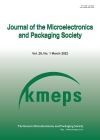Power Distribution Network Modeling using Block-based Approach
- 한국마이크로전자및패키징학회
- 마이크로전자 및 패키징학회지
- 제20권 제4호
-
2013.1275 - 79 (5 pages)
-
DOI : 10.6117/kmeps.2013.20.4.075
- 0

A power distribution network (PDN) is a network that provides connection between the voltage source supply and the power/ground terminals of a microprocessor chip. It consists of a voltage regulator module, a printed circuit board, a package substrate, a microprocessor chip as well as decoupling capacitors. For power integrity analysis, the board and package layouts have to be transformed into an electrical network of resistor, inductor and capacitor components which may be expressed using the S-parameters models. This modeling process generally takes from several hours up to a few days for a complete board or package layout. When the board and package layouts change, they need to be re-extracted and the S-parameters models also need to be re-generated for power integrity assessment. This not only consumes a lot of resources such as time and manpower, the task of PDN modeling is also tedious and mundane. In this paper, a block-based PDN modeling is proposed. Here, the board or package layout is partitioned into sub-blocks and each of them is modeled independently. In the event of a change in power rails routing, only the affected sub-blocks will be reextracted and re-modeled. Simulation results show that the proposed block-based PDN modeling not only can save at least 75% of processing time but it can, at the same time, keep the modeling accuracy on par with the traditional PDN modeling methodology.
1. Introduction
2. Evaluation of Power Distribution Network Design
3. Block-based Modeling
4. Simulation Results anD Discussion
5. Conclusion
References
(0)
(0)